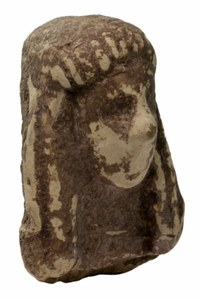Small head with strands of beads
|
Small head with strands of beads, Inv. T I-7 Solid. Front side from the mould. Back side modelled by hand, rounded head. Roughly smoothed. Very fine, light yellow (10YR 8/3) clay, heavily sintered, no engobe, no traces of paint. Provenance: Unknown. State of preservation: Broken off below the neck. Composed of two parts. Lower face damaged, mouth rubbed off. Dimensions: H: 6,8 cm; W: 5,0 cm; D: 4,2 cm. References: Not published. |
Description: Short tongues of hair frame the forehead in an arch. On both sides of the neck, thick bundles of bead-like strands fall down.
The elongated oval face, defined by the prominent nose, tapers towards the pointed chin. Close to the root of the nose are large, deep eye sockets, while the eyes themselves are barely delineated. The lips are also not visible; at best, the corners of the mouth are suggested.
Commentary: The fragment belongs to a female statuette, which is only worked out in high relief on the front. The dimensions of the head suggest a total height of the figure of approx. 28 cm. There are no signs of clothing or headgear. Whether the figure is an adorant, a cult figure or a goddess must remain open.
In terms of iconography, outline and reproduction of details, T I-7 resembles a statuette from the sanctuary of Hera Limenia in Perachora[1], which on the basis of the circumstances of the find is dated to the beginning of the 6th century BC; furthermore, it resembles a terracotta bust from the Ortheia district in Sparta[2], which was created at about the same time. The stylistic features of the Archaic period, namely the type of hairstyle, the broad upper head, the long smooth cheeks and the large-sized sensory organs, are repeated in terracotta figures and figurative vessels found both in the area of the eastern Aegean[3] and in western Greece[4]. Therefore, the small head cannot be assigned to a landscape at present.
Determination: 1st half of the 6th century BC.
 |  |
|---|
[1] R. Miller Ammerman, The naked standing Goddess, AJA 95, 1991, 225 fig. 22; listed as a kouros by G. Richter despite the clearly female breasts, dies., Kouroi (London – New York 1970) 68 figs. 163-165; P. G. Leyenaar-Plaisier, Les terres cuites grecques et romaines (Leiden 1997) 47 no. 78 b pl. 16; R. A. Higgins, Cat. (London 1954) 898 pl. 130
[2] H. Jucker, Der archaische griechische Standspiegel in Cincinnati. In memoriam Otto J. Brendel (Mainz 1976) 33-34, pl. 9a.
[3] Chr. Blinkenberg, Lindos. Les petits objets (Berlin 1931) 514 no. 2118 pl. 95; Clara Rhodos 6-7, 1932-33, 152 f. figs. 181. 182. 185; F.Işik, Die Stilentwicklung der ionischen Vogelkoren, in: F. Krinzinger (Hrsg.), Die Ägäis und das westliche Mittelmeer (Wien 2000) 330, fig. 221.
[4] Spadea, however, suggests a Corinthian or Peloponnesian workshop, R. Spadea, Ricerche nel Santuario di Hera Lacinia a Capo Colonna di Crotone (Rom 2006) 25. 27, fig. 18.


